Penny (British pre-decimal coin) facts for kids
| United Kingdom | |
| Value | 1d |
|---|---|
| Mass | (Bronze) 9.4 g |
| Diameter | (Bronze) 31 mm |
| Edge | Plain |
| Composition | |
| Years of minting | 1707–1970 |
| Obverse | |
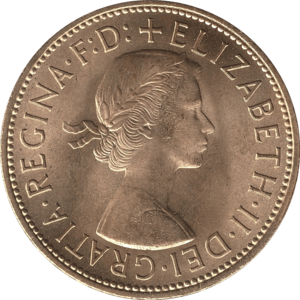 |
|
| Design | Profile of the monarch (Elizabeth II design shown) |
| Reverse | |
 |
|
| Design | Britannia (crowned letter I on earlier mintages) |
| Designer | Leonard Charles Wyon |
| Design date | 1936 |
The old British penny was a coin used in the United Kingdom. It was part of the "pre-decimal" money system, which means it was used before 1971. In this old system, one penny was worth 1/240th of a pound. It was also worth 1/12th of a shilling.
The symbol for the penny was d. This came from the Roman word "denarius." The British penny was a continuation of an even older English penny. In Scotland, it had the same value as a Scottish shilling before 1707.
At first, pennies were made of silver. But later, they were made from copper. After 1860, they were made of bronze.
When you talk about an amount of money, the plural of "penny" is "pence." For example, 8d means eight pence. But if you mean eight actual coins, you say "eight pennies."
Before Decimal Day in 1971, the British money system was different. It used pounds (£), shillings (s), and pence (d). One pound was equal to 20 shillings, and each shilling was equal to 12 pence. The penny coin was stopped in 1971. It was replaced by the decimal half new penny, which was worth about 1.2 old pence.
Contents
History of the British Penny
The kingdoms of England and Scotland joined together in 1707. This created the Kingdom of Great Britain. Before this, Scottish money was different from English money. After 1707, British money was used everywhere. The old Scottish shilling was replaced by the penny.
The design of the penny stayed the same after the countries joined. It was still made of silver after 1707. Queen Anne had pennies made in 1708, 1709, 1710, and 1713. However, these were not for everyday use. They were made as Maundy money. This is special money given out by the monarch on Maundy Thursday. Making silver coins was very expensive. So, the size of pennies had become smaller over time. Making silver pennies for regular use stopped in 1660.
Making pennies only for Maundy money continued for many years. This was true during the reigns of George I, George II, and George III. But by George III's time, there weren't enough pennies for people to use. So, many businesses started making their own copper tokens. For example, the Parys Mining Company in Anglesey made many tokens.
In 1797, the government allowed Matthew Boulton to make copper pennies. He made them at his Soho Mint in Birmingham. At that time, people thought a coin's value should match the value of the metal it was made from. So, a penny had to contain one ounce of copper. This made the coins much bigger than the earlier silver pennies. These large coins had a thick edge with the words pressed into the metal. Because of their size, people called them "cartwheels." These pennies were made for several years, but all of them show the date 1797.
Pennies in the 1800s
By 1802, private companies stopped making their own tokens. But in the next ten years, the value of copper went up. This meant that government-issued copper coins were being melted down. People started making private tokens again by 1811.
In 1816, the Royal Mint started a huge program to make new coins. They made many gold and silver coins. To stop private tokens, a law was passed in 1817. It made it illegal to make private tokens. Copper pennies continued to be made after 1797. They were made during the reigns of George III, George IV, William IV, and early Queen Victoria's reign. These later copper coins were smaller than the 1797 "cartwheel" pennies. They also had less copper.
Later, in 1860, a new type of penny was introduced. These new coins were made of bronze. Their value no longer had to match the value of the metal they were made from. This made them "much more convenient and agreeable in use." The old copper coins started to be taken out of circulation a year later.
Pennies in the 1900s
The bronze penny weighed 9.45 grams and was 30.86 millimeters wide. These measurements stayed the same for over a hundred years. Pennies were made every year during the reigns of Queen Victoria and Edward VII.
George V pennies were made every year until 1922. After a three-year break, the metal mix was changed. It became 95.5% copper, 3% tin, and 1.5% zinc. The weight and size stayed the same. This was important because many coin-operated machines and public telephones used pennies.
Pennies were then made every year for the rest of George V's reign. However, only about seven 1933 pennies were made. They were special coins placed under the foundation stones of new buildings. One of these coins was stolen when a church was torn down in the 1960s. Its location is still unknown.
A few pennies from Edward VIII exist, dated 1937. These are "pattern coins." This means they were made for official approval. The king probably would have approved them around the time he gave up his throne.
Pennies were not made every year during George VI's reign. None were made in 1941, 1942, and 1943. Pennies made in 1950 and 1951 were only for use in other countries. One 1952 penny was made by the Royal Mint, and it is believed to be the only one.
During World War II, there was a shortage of tin. So, in 1944, the metal mix changed to 97% copper, 0.5% tin, and 2.5% zinc. But this bronze did not look good as it tarnished easily. The original mix (95.5% copper, 3% tin, 1.5% zinc) was brought back in 1945.
There were many pennies already in circulation, so no more were needed in the 1950s. But many special coin sets were made in 1953 for Elizabeth II's Coronation. At least one 1954 penny was made, probably for use inside the Royal Mint.
More pennies were needed starting in 1961. Production continued every year until 1967. Pennies dated 1967 were even made until 1970. The 97% copper, 0.5% tin, 2.5% zinc mix was used again for the 1960s pennies. Finally, special "proof" coins dated 1970 were made to mark the end of the penny's use.
Types and Features of Pennies
Coins have two main sides: the "obverse" (front) and the "reverse" (back). The obverse usually shows the head of the monarch. The reverse shows a design, like Britannia.
Silver Pennies
| Years Made | Picture | Size | Weight | Material | What it looked like |
|---|---|---|---|---|---|
| 1708–1713 | 12.0mm | 0.5g | 92.5% silver, 7.5% copper | The back of this penny was like the old English penny. It had a crowned letter "I" and the words "MAG BRI FR ET HIB REG." The front showed Queen Anne's face looking left, with "ANNA DEI GRATIA" around it. | |
| 1716–1727 | 12.0mm | 0.5g | 92.5% silver, 7.5% copper | George I's coins also had a crowned "I" on the back. The front had his face. The front said "GEORGIVS DEI GRA" and the back said "MAG BR FR ET HIB REX" with the date. | |
| 1729–1760 | 12.0mm | 0.5g | 92.5% silver, 7.5% copper | This coin looked like the previous one. George II's pennies had "GEORGIVS II DEI GRATIA" on the front. The back said "MAG BRI FR ET HIB REX" with the date. | |
| 1763–1786 | 12.0mm | 0.5g | 92.5% silver, 7.5% copper | The first front design showed King George III's face looking right. It said "GEORGIVS III DEI GRATIA." The first back design, used until 1780, had a raised crowned "I." It said "MAG BRI FR ET HIB REX" with the date across the crown. Later, the "I" was flatter. | |
| 1792 | 12.0mm | 0.5g | 92.5% silver, 7.5% copper | The second front design showed an older King George III. It said "GEORGIUS III DEI GRATIA" with the date. This coin used a new back design. It had a much smaller "I" under a smaller crown. The words went around the crown. | |
| 1795–1800 | 12.0mm | 0.5g | 92.5% silver, 7.5% copper | This coin also had the second front design with an older King George III. It used a fourth back design. This was similar to the one from 1763-1780 but with a new crown design. | |
| 1817–1820 | 12.0mm | 0.5g | 92.5% silver, 7.5% copper | The fifth back design, used from 1817, showed the crowned "I." It had the words "BRITANNIARUM REX FID DEF" and the date. |
Copper Pennies
| Years Made | Picture | Size | Weight | Material | What it looked like |
|---|---|---|---|---|---|
| 1797 | 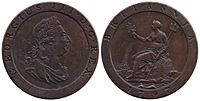 |
36.0mm | 28.3g | 100% copper | This was the "cartwheel" penny. It was made of copper and weighed one ounce. The front showed King George III's face looking right. The words "GEORGIUS III·D·G·REX" were pressed into the edge. The back showed Britannia sitting, holding a trident and an olive branch. There were waves, a small ship, and a Union Jack shield. The word "BRITANNIA" was on the top edge, and "1797" on the bottom. The word "SOHO" was next to the shield, showing it was made at the Soho Mint. |
| 1806–1807 | 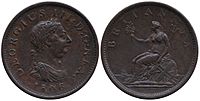 |
34.0mm | 18.8g | 100% copper | On the front, King George III's head faced right, with "GEORGIUS III D: G REX." The back showed Britannia sitting, facing left, with a shield and trident. It said "BRITANNIAR REX FID DEF." These were also made at the Soho Mint. |
| 1825–1827 | 34.0mm | 18.8g | 100% copper | The front of George IV's penny showed his head facing left. It said "GEORGIUS IV DEI GRATIA" with the date. The back showed Britannia sitting, facing right, with a shield and trident. It said "BRITANNIAR REX FID DEF." | |
| 1831–1837 |   |
34.0mm | 18.6g | 100% copper | King William IV's pennies looked very similar to the previous ones. The king's head faced right, with "GULIELMUS IIII DEI GRATIA" and the date. The back was the same as the George IV penny. |
| 1841–1860 |  |
34.0mm | 18.8g | 100% copper | This coin featured the "Young Head" design of Queen Victoria. |
Bronze Pennies
| Years Made | Picture | Size | Weight | Material | What it looked like |
|---|---|---|---|---|---|
| 1860–1894 | 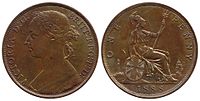 |
31.0mm | 9.4g | 95% copper, 4% tin, 1% zinc | This coin showed the second design of Queen Victoria's head. The back of the bronze coin showed Britannia sitting, holding a trident. The words "ONE PENNY" were on either side. |
| 1895–1901 | 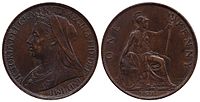 |
31.0mm | 9.4g | 95% copper, 4% tin, 1% zinc | This coin featured the third and final "Old Head" (or "veiled head") design of Queen Victoria. |
| 1902–1910 |   |
31.0mm | 9.4g | 95% copper, 4% tin, 1% zinc | During King Edward VII's reign, the lighthouse and ship next to Britannia were removed. The sea level design was also changed to be higher. |
| 1911–1922 |   |
31.0mm | 9.4g | 95% copper, 4% tin, 1% zinc | |
| 1925–1936 | 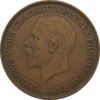 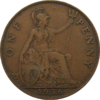 |
31.0mm | 9.4g | 95.5% copper, 3% tin, 1.5% zinc | |
| 1937–1943 |  |
31.0mm | 9.4g | 95.5% copper, 3% tin, 1.5% zinc | During the reign of George VI, the lighthouse was put back on the left side of Britannia on the back of the coin. Her shield was also turned upright. |
| 1944 | No change in design | 31.0mm | 9.4g | 97% copper, 0.5% tin, 2.5% zinc | |
| 1945–1952 | No change in design | 31.0mm | 9.4g | 95.5% copper, 3% tin, 1.5% zinc | George VI coins made before 1949 said "GEORGIVS VI D G BR OMN REX F D IND IMP." After 1949, they said "GEORGIVS VI D G BR OMN REX FIDEI DEF." |
| 1953–1954 | Same design as below | 31.0mm | 9.4g | 95.5% copper, 3% tin, 1.5% zinc | Pennies were not made often during the early reign of Elizabeth II. But those made for her coronation in 1953 said "ELIZABETH II DEI GRA BRITT OMN REGINA F D." |
| 1961–1970 | 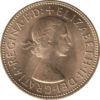 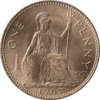 |
31.0mm | 9.4g | 97% copper, 0.5% tin, 2.5% zinc | Regular making of pennies started again in 1961. Pennies made after this date said "ELIZABETH II DEI GRATIA REGINA F D." |
History of Pennies by Time Period
- The Anglo-Saxons (around 600–1066)
- The early Normans and the Anarchy (1066–1154)
- The Plantagenets (1154–1485)
- The Tudors (1485–1603)
- The Stuarts and the Commonwealth (1603–1714)
- The Hanoverians (1714–1901)
- The 20th century before decimalisation (1901–1970)
- Decimal Day, 1971
- After decimalisation (1971–present)
How Many Pennies Were Made?
"Mintage" means the number of coins made in a specific year. Here are the numbers of pennies made during different reigns.
| George IV |
|---|
|
| William IV |
|---|
|
| Victoria (Young bust) |
|---|
|
| Victoria (Draped bust) |
|---|
|
| Victoria (Veiled bust) |
|---|
|
| Edward VII |
|---|
|
| George V |
|---|
|
| George VI |
|---|
|
| Elizabeth II |
|---|
|
Note: If you see "H" or "KN" after a year, it means the coins were made at a different mint. "H" means the Heaton Mint, and "KN" means the King's Norton Mint. These mints sometimes helped make extra pennies.
From 1825 to 1970, over 3.6 billion pennies were made in total!
See also

